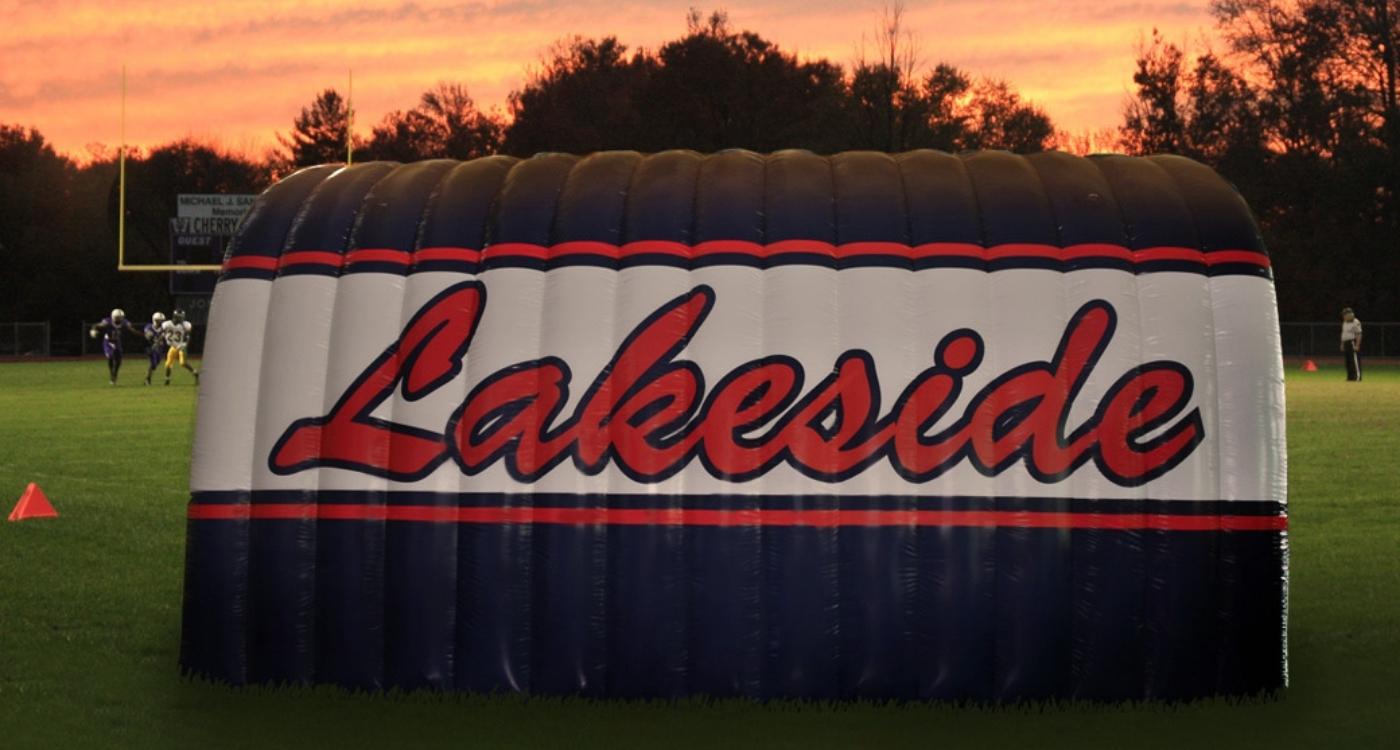Inflatable entrance tunnels are a great way to make a significant impact at your next event. They're perfect for adding excitement and generating buzz as guests arrive. But using them can be daunting if you're not sure how they work.
The processes of setting up, inflating, and taking down an inflatable entrance tunnel are fundamental for the effective use of these structures. Performing just one of these steps incorrectly can lead to problems and potentially ruin the tunnel.
The moment you damage your custom inflatable entrance while setting it up, all the excitement and anticipation for your event goes out the window. To help you avoid any mishaps, we've put together four easy tips to help you use these structures with no stress.
Tip #1: Read the Instructions

Inflatable Entrance Tunnel
Instructions are there for a reason. Inflatable entrance tunnel manufacturers know what works best for an impressive experience. They curate instructions based on:
- Their years of experience with inflatable products.
- The materials used to make the tunnel.
- Safety aspects you need to consider during setup, inflation, and takedown.
Reading the instructions helps you understand how an inflatable entrance tunnel works and what's involved in the setup process.
Every tunnel is slightly different based on the material used. They're usually made of either denier polyester or PVC. Even if you have used an inflatable entrance tunnel before, it's necessary to read instructions to know the specific guidelines for a given model.
Reading the instructions makes using an inflatable entrance tunnel easy by:
- Helping you to plan for your event, as the instructions tell you the required equipment for better functioning of the tunnel.
- Giving you a better understanding of the setup process.
- Allowing you to make any necessary changes before setting up, inflating, or taking down the structure after knowing what each step entails.

Tip #2: Have All Equipment Readily Available Before Setup Begins
Every minute counts, and you don't want your guests to arrive before you complete setting up your inflatable entrance tunnel. The best way to maximize your time is to have all equipment ready before setup.
You don't want the confusion that comes with starting the setup process and realizing you're missing some tools. This sets the tone for a rushed and stressful setup—the last thing you want.
Equipment Needed Before Setting up an Inflatable Entrance Tunnel
You need the following equipment for a stress-free setup:
- The inflatable, tie-down ropes and stakes: Lay the tunnel flat and attach the tie-down ropes to its metal rings; then, secure the other end of the ropes to the ground stakes. You can wait to put the stakes in the ground until it's fully inflated.
- Inflating blower: This inflates the tunnel. Make sure it's in good working condition before starting the setup process.
- Tarp or other ground covering: This isn't required, but you may want to set this underneath the inflatable entrance tunnel to prevent it from getting damaged by sharp surfaces and moisture.
This equipment will help you perform different activities needed during the setup, inflation, and takedown stages, as shown in the table below:
| Stage | Activities |
| Setting up the tunnel |
|
| Inflating the tunnel |
|
| Taking down the tunnel |
|
Expert Tip: MVP Visuals provides free layouts, samples, and no setup fees for those who don't want to struggle with the processing of setting up the tunnel. We ensure that the material, placement, sizing, and colors suit your needs. Get started by asking for a quick quote.
Here’s what one of our customers had to say:
“Easy to work with, accommodating, and prompt from design to product arrival!”
Kyle, USA
Tip #3: Set Up in a Clear Area

Customized Inflatable Entrance Tunnel
This is a safety feature to ensure your inflatable entrance tunnel serves you until the end of the event. The worst disappointment when using a tunnel is to see it collapsing during the event. In most cases, this happens due to deflation.
Inflatable entrance tunnels get filled with pressurized air. Any sharp or abrasive object in the surrounding area is hazardous to your tunnel.
Clear all debris, branches, and sharp objects from the setup site. This prevents them from damaging your inflatable entrance tunnel during setup or while using it at the event.
Keep children and animals away as they may accidentally damage the tunnel. This doesn't mean that children shouldn’t use the tunnel—but they need to be supervised while playing by it.
The following processes are crucial to ensure the setup area is clear:
- Remove all obstacles in a 15-foot radius around the site.
- Ensure there's nothing above the tunnel when it inflates, as this will prevent full inflation of the tunnel.
- Check for overhead power lines and other hazards before setting up the frame.
Expert Tip: Don’t set up the tunnel under trees. Branches might fall on your structure, causing damage when used at the event or during setup.
Tip #4: Check the Weather Forecast
Weather is a crucial factor when using an inflatable entrance tunnel. Adverse weather elements like wind and rain can destroy the structure or make your guests uncomfortable.
Inflatable entrance tunnels are made with materials that can withstand moderate weather conditions like rain and wind. However, the elements can become too strong for your tunnel when they're extreme. Checking the weather forecast is crucial before setting up a tunnel.
If there's a high chance of rain or strong winds, take one of the following actions:
- Reschedule your event to a day with better weather.
- Don't set up the inflatable entrance tunnel if you're not using it for an event or activity. Store it safely until you need to use it again.
- Reschedule the event venue to safer grounds if you can’t call it off.
Effects of Adverse Weather Elements on Inflatable Entrance Tunnels
- Heavy rain: It destroys inflatable entrance tunnels by causing corrosion and mold.
- Strong wind: Wind is a safety hazard for inflatable structures. Strong gusts will blow away your inflatable entrance tunnel or cause it to collapse if it's not appropriately anchored to the ground.
- Lightning: Lightning strikes are dangerous for people and equipment near the structure. It can cause a fire or electrocute people in the area.
- Snow: Snow adds weight to inflatable entrance tunnels and causes them to collapse if you don't clear it off the structure regularly.
Over to You Now
We at MVP Visuals have spent over 15 years working with brands from different industries to help them increase their return on investment through custom inflatables.
We guarantee timely delivery, customer support, and customized inflatable designs that’ll meet your needs. Get a quick quote today for your customized inflatable entrance tunnel.
Check out what one of our happy customers had to say:
Frequently Asked Questions
Do I need to inflate the entrance tunnel constantly?
It depends if you have a sealed-air or a constant-air inflatable. It may vary depending on size and material of your tunnel.
If you have a sealed-air inflatable, only use the blower when the tunnel is being inflated and then again if it loses some pressure.
If you have a constant-air inflatable, then the blower needs to be on and hooked up to the inflatable the entire time in use.
How do you keep the tunnel in place when it's windy?
When there are strong winds, keep the tunnel in place by using tent stakes or heavy-duty weights to anchor it down. Use caution when setting up an inflatable entrance tunnel if a wind advisory is in effect.
NOTE: We don't recommend using your inflatable in wind gusts above 15mph.
Can I use my own blower?
No. You must use the blower specified by the manufacturer for use with your inflatable entrance tunnel. Failure to do so may damage the blower or cause improper inflation of the tunnel.
Share on Facebook:





